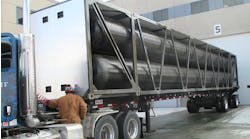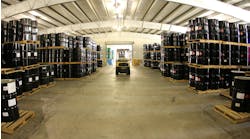Heniff acquires New Orleans tank wash
JF Lehman acquires Atomic Transport
2018 Oilfield Forecast— Excitement building for US oil companies after record crude oil production in 2017
OVERALL, US oilfield operations continued to show improvement over the past year, with crude oil production reaching record levels. 2018 should be even better based on current projections.
In December 2017, the US Energy Information Administration issued a Short-Term Energy Outlook (STEO) forecasting that US crude oil production averaged 9.3 million barrels per day (b/d) in 2017, up 0.5 million b/d from 2016. In 2018, EIA expects crude oil production to reach an average of 9.9 million b/d, which would surpass the previous record of 9.6 million b/d set in 1970.
EIA forecasts that most of the growth in US crude oil production through the end of 2018 will come from tight rock formations within the Permian region in Texas and from the Federal Gulf of Mexico. The Permian region is expected to produce 2.9 million b/d of crude oil by the end of 2018, about 0.5 million b/d more than the estimated June 2017 production level, representing nearly 30% of total US crude oil production in 2018. The Permian region covers 53 million acres in the Permian Basin of western Texas and southeastern New Mexico.
Within the Permian Basin are smaller sub-basins such as the Midland Basin and the Delaware Basin, which contain historically prolific non-tight formations as well as multiple prolific tight formations such as the Wolfcamp, Spraberry, and Bone Spring. With the large geographic area of the Permian region and stacked plays, operators can continue to drill through several tight oil layers and increase production even with sustained West Texas Intermediate (WTI) crude oil prices below $50 per barrel, according to EIA analysis.
Rig count
Based on the Baker Hughes rig count, 366 of the 915 onshore drilling rigs in the Lower 48 states in June 2017 were operating in the Permian region. In addition, 1,212 well service rigs were active (accounting for about 42% of the total units across the industry), as of September 2017, throughout the United States, according to the most recent report from the Association of Energy Service Companies (AESC). Of those, 399 were in the Permian Basin and West Texas.
While the Permian Basin claimed the starring role last year, it wasn’t the only active US oilfield. Other areas seeing more activity include the Bakken Shale in North Dakota, the Haynesville Shale in Texas and Louisiana, Oklahoma oilfields, the Colorado and Wyoming Shale, and the Marcellus Shale.
“It’s definitely getting busier in the US oilfields,” says Kenny Jordan, AESC executive director. “On the service side, we’re seeing improved utilization of equipment such as well service rigs. In the latest AESC report about 42% of the total well service rigs in the United States were active. There is still over capacity in the well service sector, and a lot of service equipment is still parked. Those factors are depressing rates for oilfield services.
“We believe the mergers and acquisitions that are now underway should reduce over capacity. More companies are hiring workers again. Many are trying to bring back workers furloughed during the worst of the oilfield downturn, but it’s a tough chore. A lot of experienced workers were lost through the layoffs and many are not coming back.”
Midstream operations
Midstream companies should have a very good year, especially those
operating in the Bakken and Marcellus shale plays, according to a new report from East Daley Capital Advisors Inc. The report goes on to say that the Bakken formation, located primarily in North Dakota, will rebound from 2017 levels and midstream companies located in that region will benefit greatly. East Daley sees a turnaround in the Bakken as rig activity has increased steadily throughout 2017 as crude prices stabilized.
“The most influential midstream theme in 2018 is our forecast for significant oil and gas production growth,” said Justin Carlson, vice-president and managing director, research at East Daley Capital. “The main lag with production in 2017 has been the long lead time for contracting frac crews needed to complete the newly-drilled wells. We see that changing dramatically in 2018. We do not anticipate that being an issue as field service providers are really ramping up their frac fleets. Completions will increase significantly in 2018.
“The Marcellus will continue to be the best location for midstream companies exposed to natural gas. Production in the Northeast is poised to ramp up significantly in 2018 as new pipeline projects debottleneck the region.”
The projected increase in completions would take a lot of well service company support. Completing a well involves casing, cementing, perforating, and hydraulically fracturing to make it ready for producing.
Frac sand
Demand for raw frac sand is forecast to increase over 4% per year to nearly 100 billion pounds in 2021. In value terms, raw frac sand is expected to grow 10% per year to over $3 billion in 2021, reflecting substantial gains in average prices as well as volume growth. These and other trends were discussed in “Proppants Market in North America,” a new study from The Freedonia Group, a Cleveland-based industry research firm.
The average oil or gas well now uses 5,500 tons of frac sand, up from 5,250 tons in early 2017. Increasing lateral lengths, stage counts, and proppant intensity levels have all contributed to a significant uptick in frac sand consumption.
Sand per well has increased to the point where entire unit trains (75-125 railcars) are used just to complete a single well. Higher sand intensity, longer laterals, more stages, increasing rig counts, and fewer drilling days per well create a seemingly endless demand for frac sand.
More chemicals are going into the drilling and production process. The value of North American oilfield chemicals market was estimated at $15.4 billion in 2017, and is likely to reach $19,6 billion by 2022.
Oilfield chemicals have become an integral part of the oil and gas industry and are used in various stages of oil exploration. The usual problems that oilfields face include water gushing into the oil well during drilling and exploration and gases like carbon dioxide and hydrogen sulfide causing equipment corrosion. Moreover, the metal scale formed during drilling operations can interfere with the machine operations. Oilfield chemicals, especially corrosion and scale inhibitor chemicals, can mitigate many of the problems.
Polymers are expected to experience some of the highest annual growth for the oilfield chemical sector. Increasing well stimulation and drilling activities also are estimated to boost the oilfield chemicals market.
Water handling
Water is another key factor in oilfield operations. Recent months brought a number of changes for the water handling sector—including construction of new treatment and disposal facilities and mergers and acquisitions.
Milestone Environmental Services opened a new state-of-the-art facility in the Midland (Texas) Basin in December 2017 that will primarily handle drilling waste streams, including water- and oil-based drilling mud and some completion and production waste.
Produced Water Transfer obtained fresh capital for expansion and growth of its water gathering and disposal systems in the Cotton Valley and Haynesville shale plays. Midland Basin Partners LLC obtained a $75 million credit facility from Orion Energy that will fuel the expansion of MBP’s existing midstream platform focused on water infrastructure. MBP provides responsible water sourcing, transportation and storage solutions to energy producers in the Permian Basin, with an initial focus on the Midland Basin.
Stallion Oilfield Services Ltd announced that it has completed its acquisition of substantially all of the assets of Basin Wastewater Solutions LLC, a provider of rig site potable water and wastewater recycling services. Basin is based in Carlsbad, New Mexico and services the entirety of the Permian market.
That is just a sampling of the developments in the oilfield water transport, processing, and disposal sector over the past year. More changes almost certainly are coming as drilling and production activity steadily increases in coming months.
Vacuum transports will remain a critical component in the water handling process. Oilfield truck fleets also will keep busy hauling crude oil, condensate, frac sand and other proppant materials, and chemicals.
While pipelines are moving more crude oil and condensate out of the oilfield, plenty of tank trucks will still be needed. Going forward, the biggest challenge may be finding enough drivers to meet the US oilfield needs.
“Thousands of truck drivers left the oilfield when the shale boom crashed,” AESC’s Jordan says. “Like other oilfield workers, some drivers with oilfield experience will never return. They don’t want to run the risk of getting burned again.”
At the same time, US oilfields are busy and could be headed for another record year. Excitement is building.








